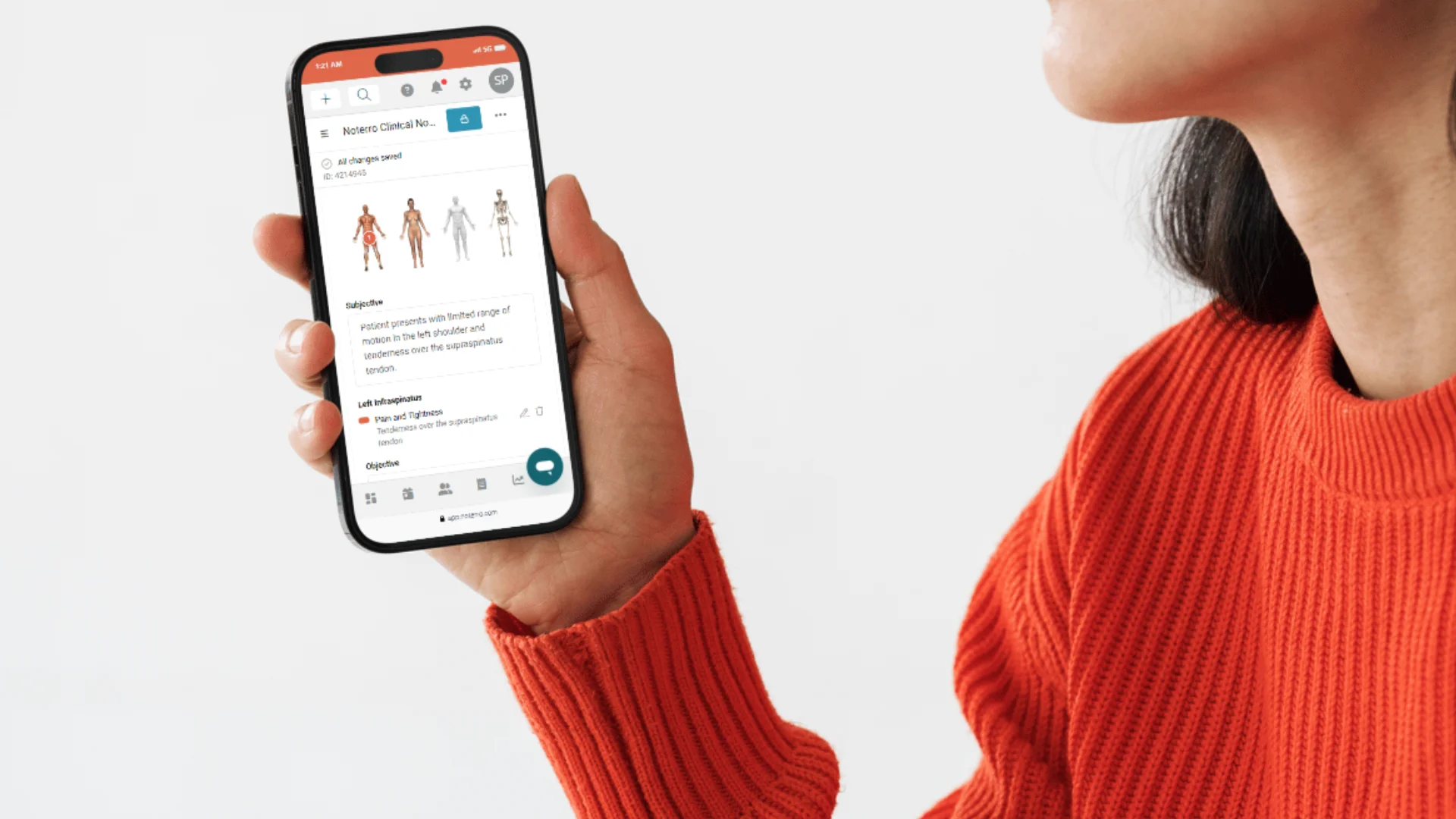Upcoming Cyber Monday Deal: Subscribe Between Nov. 28 & Dec. 5 to get 3 months free!
Learn More
Table of Contents

Experience Better Practice Management Today!
Starting at $28.05/month
No Credit Card Required

Experience Better Practice Management Today!
Starting at $30/month
No Credit Card Required
Charting is the backbone of effective clinical practice.
Accurate, detailed records are critical to patient care, communication among healthcare professionals, and legal compliance. Yet, traditional methods of paper-based charting can be cumbersome and prone to error.
Enter digital charting—a modern solution that is not only revolutionizing patient record management but also reshaping clinical standards.
A study highlights how AI tools are revolutionizing healthcare documentation by reducing administrative burdens on clinicians, which helps prevent burnout and enhances job satisfaction.
AI-powered tools, as noted in recent studies, reduce clinician burnout, improve collaboration, and ensure more accurate and comprehensive records, thereby enhancing overall patient care and clinical outcomes.
These tools also improve patient care by freeing up time for more direct interactions and decision-making. AI promotes better collaboration by enabling seamless data exchange and creating more comprehensive patient profiles.
Additionally, AI algorithms help ensure accuracy and completeness in medical records, improving both the quality of care and long-term health outcomes.
In this blog, we will explore how digital charting is transforming healthcare, streamlining processes, and boosting patient outcomes.
Charting used to be a messy, error-prone task in healthcare.
For decades, healthcare providers relied on paper charts—bulky files, handwritten notes, and a seemingly endless stream of forms that were prone to errors and misplacement. These paper-based systems posed numerous challenges, such as:
The process was tedious and unreliable, especially when searching through cabinets for six-month-old notes to recall something as specific as a patient's neck pain or what they were treated for.
As technology advanced, so did the push for more efficient, error-proof systems. Digital charting was born, transitioning healthcare from manual processes to streamlined, electronic solutions.
Digital charting is revolutionizing healthcare by replacing traditional paper-based systems with efficient, real-time access to patient records. This shift is improving workflows allowing healthcare professionals to focus more, here’s how:
One of the greatest frustrations with paper charting was its readability. Illegible handwriting was not only unprofessional but also unstructured. Now, with digital systems, every note is polished, readable, and much easier to understand.
More importantly, patient care has significantly improved. Remembering a patient's condition from six months ago is no longer reliant on memory or misplaced notes.
It’s all there online—quick, accurate, and ready to guide the next step in treatment.
Imagine a patient filing for insurance claims or, worse, facing a lawsuit. Handwritten notes with vague or unclear information would not be helpful.
On the other hand, organized, drafted reports provide clear documentation, offer peace of mind, and protect both the clinician and the patient.
With real-time access to patient data, streamlined workflows, and advanced analytics, digital charting has become an indispensable tool for enhancing clinical decision-making and optimizing patient outcomes across the board,
| Technology | Description | Benefits | Drawbacks |
|---|---|---|---|
| Voice-to-text dictation with AI | Converts spoken notes directly into the EHR using natural language processing. |
• Faster charting • Reduced typing • May include clinical decision support |
• May require manual corrections for accuracy • Can struggle with accents or complex medical terms |
| AI-Powered Chart Summarization | Creates concise summaries of patient interactions from dictations and notes for EHR integration. |
• Saves time reviewing notes • Improves charting efficiency • Highlights key information and discrepancies |
• May miss subtle details or misunderstand context • Requires physician oversight for accuracy • Potential privacy risks with third-party tools |
| Clinical Documentation Improvement Tools | Reviews medical records for accuracy and completeness, suggesting diagnosis and coding enhancements using natural language processing and machine learning. |
• Ensures accurate billing and reimbursement • Identifies documentation gaps • Assists with complex coding |
• May produce false positives or unnecessary suggestions • Over-reliance can lead to missed diagnoses |
| Virtual Scribes | Combines AI-driven voice recognition with human scribes to review and refine transcribed notes. |
• Real-time documentation assistance during visits • Reduces administrative burden on physicians |
• More expensive than AI-only solutions • Requires final physician review • Possible privacy concerns with third-party scribes |
Table 1: Transforming Health Care With Artificial Intelligence: Redefining Medical Documentation
Digital charting is not just about convenience—it's about creating a seamless experience for both practitioners and patients. Electronic Health Records (EHR) systems are at the core of most digital charting tools, integrating patient information across various departments and ensuring continuity of care.
With healthcare data moving online, patient privacy and data security are vital concerns. Modern digital charting systems, like Noterro, use advanced encryption methods to ensure that patient information remains confidential and secure.
These systems offer secure, cloud-based access to records while adhering to strict security and privacy standards under regulations like HIPAA and PIPEDA. Encryption, regular backups, and user authentication protocols are in place to protect sensitive patient information.
Moreover, healthcare providers can rest assured that records are compliant regulations, safeguarding sensitive information and preventing unauthorized access.
While digital charting offers numerous advantages, the transition isn’t without challenges.
Some clinicians may experience a steep learning curve when adopting new systems, especially those unfamiliar with technology. However, the long-term benefits of time savings, accuracy, and better patient care far outweigh the initial hurdles.
Additionally, with continuous updates and user-friendly interfaces, most healthcare providers adapt to the new system quickly.
The switch to digital charting doesn't just streamline workflows; it fundamentally enhances the quality of care.
Automation eliminates the need for redundant tasks, allowing providers to focus on patient care. Digital records can be updated in seconds, drastically reducing the time spent on paperwork
Digital systems often come with built-in billing and coding functionalities that streamline the claims process, reduce errors, and speed up reimbursements.
Digital charting provides access to advanced tools and algorithms that aid in clinical decision-making, helping practitioners identify potential issues and treatment options more effectively.
Digital charting systems often include scheduling and workflow management features that improve patient flow, reduce wait times, and optimize appointment scheduling.
Digital records minimize human error—no more misreading illegible handwriting or missing critical information due to a misfiled document.
The days of rummaging through stacks of paperwork are over. Digital systems allow for efficient search and retrieval of patient histories, lab results, and past treatments.
For specialties such as dermatology and plastic surgery, before-and-after photos are essential. Digital charting allows for easy storage and comparison of images over time, helping track progress and refine treatment plans.
From appointment scheduling to diagnosis and billing, digital charting systems link all aspects of clinical operations, creating a unified workflow that boosts efficiency and collaboration.
Providers can access records remotely, ensuring they are always up-to-date on their patients, even when out of the office. This flexibility supports better continuity of care.
However, it's not always a smooth sail. Some facilities face training challenges when adapting to new systems, and staff may need time to learn the new technology. But once implemented, the benefits far outweigh the initial learning curve.
The digital charting revolution is just beginning, with technological advancements, we can expect to see more features, such as:
We are moving towards an AI-driven future in healthcare, where AI tools don’t just document but also help recall information, suggest treatments, and even summarize patient history in a few sentences. AI-powered systems save time and eliminate manual processes, offering doctors summaries that prompt action they might not have considered.
Think of it this way, relying on traditional paper charting today is like using a hammer when you have a power tool available.
Why choose the slow, manual option when there’s something faster, more efficient, and infinitely smarter?
AI is the future of charting, and those who adopt it early will find themselves far ahead of the curve. With everything stored digitally, accessible at your fingertips, the time saved is invaluable, and not just for doctors but for patients too.
Digital charting isn't just about documentation, it's about redefining the standard of care in healthcare.
The future of digital charting holds the promise of even more personalized care and improved clinical outcomes, pushing the boundaries of what healthcare can achieve.
Digital charting is no longer just an option—it’s the future of clinical practice.
The transformation from paper-based systems to digital solutions brings efficiency, accuracy, and better patient care to the forefront. Healthcare providers who embrace this shift will be better positioned to meet the evolving demands of modern healthcare.
Digital charting is the tool that will keep clinics ahead of the curve. The road ahead is one of innovation, and those who adapt will reap the rewards.
Tags



